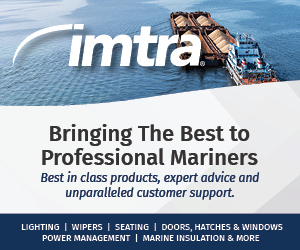Subchapter M: The Sausage Is Still Being Ground
The May 22 panel discussion of Subchapter M at the Inland Marine Expo was packed, with standing-room only. It was one more sign that interest in Subchapter M remains high, as a key deadline is set to kick in this July 20. The audience questions covered a range of topics, and final answers on many key points are still being awaited.
The panel was moderated by Dave Hammond, co-owner and president of Inland Marine Service, the largest vessel management company in the U.S. Among the panel members were Steven Douglass, a civilian Coast Guard expert at the Coast Guard’s Towing Vessel National Center of Expertise (TVNCOE); Paul Hite, a senior surveyor with ABS with extensive deck experience on oceangoing vessels; Jason Adams, chief operations officer at Inland Marine Service; and Chris Parsonage, executive director of the Towing Vessel Inspection Bureau (TVIB).
Douglass began by asking the audience how many options there were for Subchapter M compliance (there are two). He reminded audience members that it is the Coast Guard, not any third-party organizations (TPO), that issue certificates of inspection (COIs) in all cases, even when a company used a TPO. A COI lasts for five years and the current fee is $1,030, although that may change, he said. The first inspection for a COI is free.
The COIs are being issued on a four-year staggered schedule. All vessels are supposed to be inspected by July 2022. Beginning this July 20, one-quarter of a company’s vessels will need to be certified, with another quarter for each of the succeeding three years.
Douglass reminded members that Subchapter M applies to all vessels, whether or not they have a COI.
Persons In Addition To Crew
One issue connected to Subchapter M is coming to light now that COIs are beginning to be issued. A COI must include a list of how many crew members regularly crew a vessel, plus the number of “persons in addition to the crew” who might ride it, up to 16 per vessel for a domestic voyage, or 12 for an international voyage. Those persons might be extra crew, company officials, contractors or passengers.
But a set of lifesaving and firefighting equipment for each additional person, up to the maximum amount, must be maintained by the company. In response to a question, Douglass said the extra sets might not have to be aboard at all times unless the extra people are. That determination might be left to the officer in charge of marine inspections (OCMI).
But he said that even during crew changes, for example, when the number of crewmembers is briefly doubled, there would have to be a set aboard for each crew member. It’s an expense many companies have not yet thought about.
Vessels can apply for extension permits. Douglass noted that a guidance on the issue of manning scales under Subchapter M was published by the Coast Guard last July. Guidances are not supposed to have the binding power of law, but can effectively do so in practice.
Many of the questions concerned “excepted vessels” that don’t have to comply with certain parts of Subchapter M because they operate in a limited geographical area (LGA). The Coast Guard Captain of the Port will decide what constitutes an LGA, said Douglass. This typically means harbor vessels that stay in one harbor or do not have sleep-over crew. Douglass reminded members that Subchapter M applies to all vessels, whether or not they have a COI. The firefighting provisions of Sections 142-315 might not apply to LGA boats, he said.
David Hite spoke on “Survey Considerations From A Class Perspective.” The class societies such as ABS have been accepted as TPOs by the Coast Guard and have experience surveying and auditing vessels. Hite noted that existing non-classed vessels are not subject to ABS rules for annual vessel surveys.
Hite reminded audience members of Coast Guard Policy letter 17-10 that allows companies to set up a timetable for compliance with some Subchapter M requirements not related to safety or firefighting. The nonconformities are entered into the Coast Guard’s Marine Information for Safety and Law Enforcement (MISLE) database system, but not the public-facing part.
“Develop a relationship with your OCMI,” Hite advised, along with the other panel members.
Adams noted that his company, Inland Marine Service, helped with efforts to get Coast Guard approval for the Responsible Carrier Program five years ago. He said that fostering a company culture of compliance and safety is more challenging than the “aesthetics” of compliance. Inland Marine reorganized its structure, assigning more people to compliance full-time.
Parsonage said that his firm, TVIB, which trains vessel auditors, now has more than 80 customers representing about 1,100 vessels. TVIB’s auditors are located in 20 states and are increasing all the time. Most, he noted, have brown-water backgrounds.
Parsonage listed what he said were the top five advantages of a TSMS option. Most had to do with increased flexibility, such as getting “permits to proceed” from the Coast Guard while correcting minor nonconformities. A TPO will handle that request process for the company. The corrective action process is also more flexible with a TPO, he said.
TVIB has issued 55 TSMS certificates to date.
Parsonage said there remain some inconsistencies of interpretation among the OCMIs. “[Coast Guard] marine inspectors are still not fully aware of the TPO role or what it is we do,” he said.
Editor’s note: Much more coverage from the Fifth Anniversary Inland Marine Expo will appear in the WJ in coming weeks.


